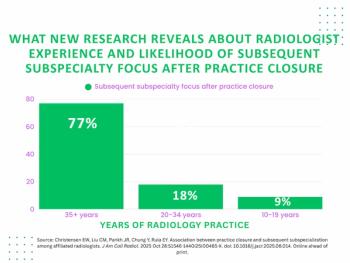SNMMI: Study Shows Viability of FAPI PET/CT for Predicting Progressive Pulmonary Fibrosis in Lung Disease Patients
For patients with interstitial lung disease, FAPI PET/CT was more effective than 18F-FDG PET/CT at predicting progressive pulmonary fibrosis according to comparative study findings presented at the 2024 Society of Nuclear Medicine and Molecular Imaging (SNMMI) Annual Meeting.
Emerging research suggests that fibroblast activation protein inhibitor (FAPI) positron emission tomography/computed tomography (PET/CT) may be more advantageous than 18F-FDG PET/CT for early detection of progressive pulmonary fibrosis (PPF) in patients with interstitial lung disease (ILD).
In the comparative study, presented at the
While both imaging modalities demonstrated an 89 percent specificity rate for predicting PPF, the researchers found that FAPI PET/CT had a significantly higher area under the curve (AUC) than 18F-FDG PET/CT (98 percent vs. 81 percent) and a 33 percent higher sensitivity rate (100 percent vs. 67 percent).
“While 18F-FDG PET/CT can offer some information about ILDs, FAPI PET/CT could provide even more information to physicians, especially regarding progressive pulmonary fibrosis. This could make it a promising diagnostic tool,” noted lead study author Qi Fang, M.D., a resident in the Department of Nuclear Medicine at Guangzhou Medical University in Guangzhou, China.
The researchers noted the whole lung SUVmean (WL-SUVmean) was a key differentiating parameter. Overall, the WL-SUVmean was significantly higher with FAPI PET/CT in comparison to 18F-FDG PET/CT (1.04 vs. 0.82). Patients with PFF demonstrated a higher WL-SUVmean than those without PPF (1.24 vs. 0.73), according to the study authors.
Fang and colleagues suggested the WL-SUVmean could be a “pivotal parameter” with FAPI PET/CT as a key source of metabolic information in patients with ILD.
“These findings underscore the potential utility of FAPI PET/CT as an imaging modality for diagnosing ILD,” said Fang. “In particular, our research shows that patients with high whole-lung SUVmean on FAPI scans tend to manifest progressive pulmonary fibrosis one year later. As such, these patients should be more carefully treated, and anti-fibrosis treatment should begin as early as possible.”
(Editor’s note: For additional content from the SNMMI conference, click
Reference
1. Fang Q, Zhao R, Cui J, et al. Comparative analysis of FDG and FAPI PET/CT imaging in interstitial lung disease: focused on progressive pulmonary fibrosis prediction. Presented at the 2024 Society of Nuclear Medicine and Molecular Imaging (SNMMI) Annual Meeting, June 8-11, Toronto, Canada. Available at:
Newsletter
Stay at the forefront of radiology with the Diagnostic Imaging newsletter, delivering the latest news, clinical insights, and imaging advancements for today’s radiologists.































